语法知识—情态动词的图文解析
- 格式:doc
- 大小:40.00 KB
- 文档页数:7
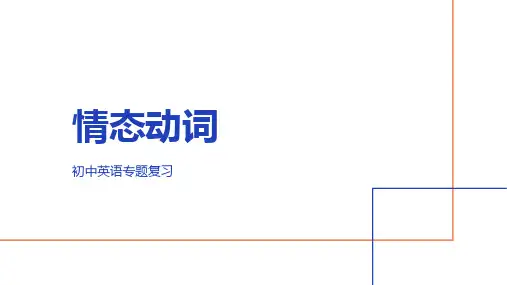
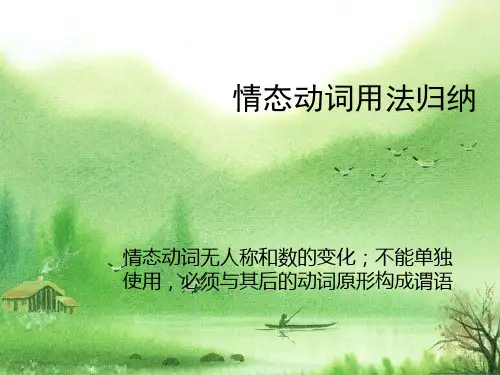
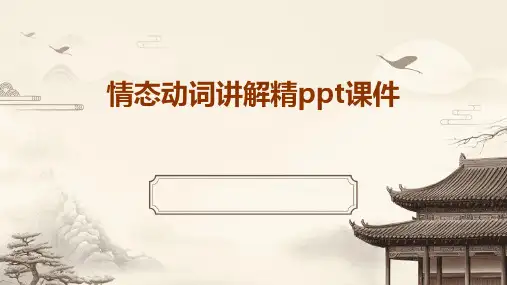
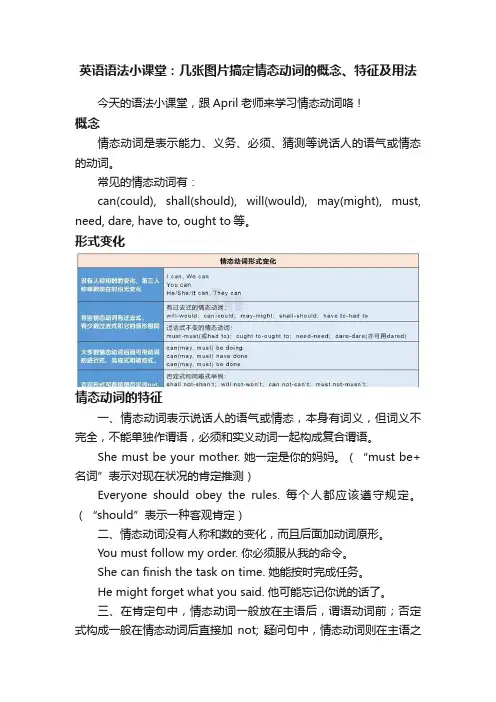
英语语法小课堂:几张图片搞定情态动词的概念、特征及用法今天的语法小课堂,跟April老师来学习情态动词咯!概念情态动词是表示能力、义务、必须、猜测等说话人的语气或情态的动词。
常见的情态动词有:can(could), shall(should), will(would), may(might), must, need, dare, have to, ought to等。
形式变化情态动词的特征一、情态动词表示说话人的语气或情态,本身有词义,但词义不完全,不能单独作谓语,必须和实义动词一起构成复合谓语。
She must be your mother. 她一定是你的妈妈。
(“must be+名词”表示对现在状况的肯定推测)Everyone should obey the rules. 每个人都应该遵守规定。
(“should”表示一种客观肯定)二、情态动词没有人称和数的变化,而且后面加动词原形。
You must follow my order. 你必须服从我的命令。
She can finish the task on time. 她能按时完成任务。
He might forget what you said. 他可能忘记你说的话了。
三、在肯定句中,情态动词一般放在主语后,谓语动词前;否定式构成一般在情态动词后直接加not; 疑问句中,情态动词则在主语之前。
You had better think hard about it. 你最好仔细想想。
You musn't break the rules and regulations. 你不准违反规章制度。
Can you take my advice? 你能接受我的建议吗?How dare you say like that! 你怎敢那样说呢!常见情态动词用法常见情态动词的用法-can/could常见情态动词的用法-may/might常见情态动词的用法-must常见情态动词的用法-shall/should常见情态动词的用法-ought常见情态动词的用法-will/would常见情态动词的用法-need/dare亲爱的宝宝们,快来收藏这些图片吧,英语中情态动词的学习就基本搞定啦!。
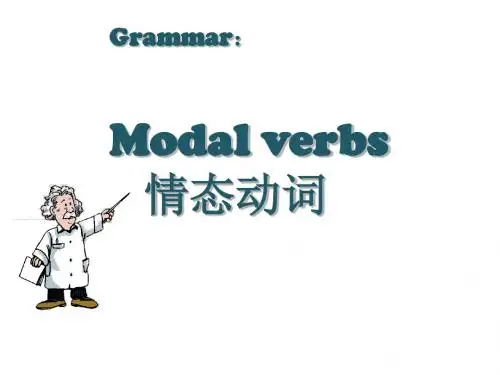
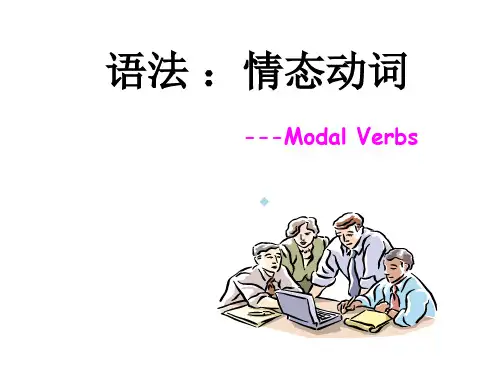
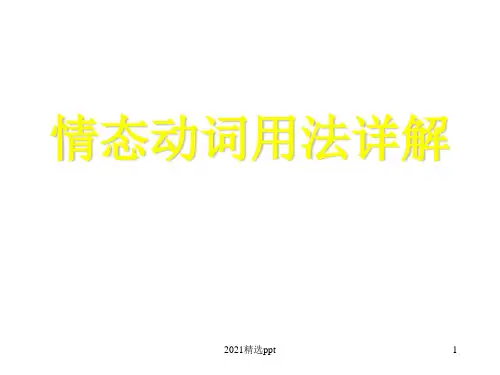
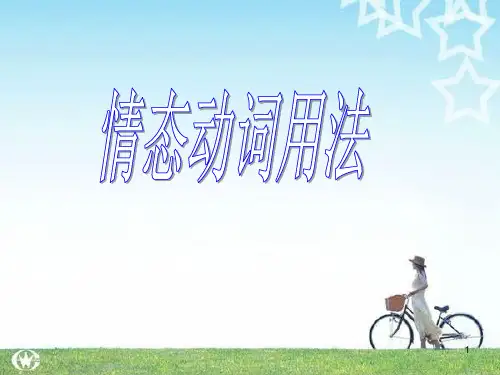
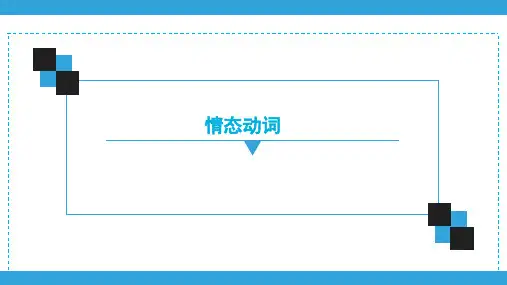
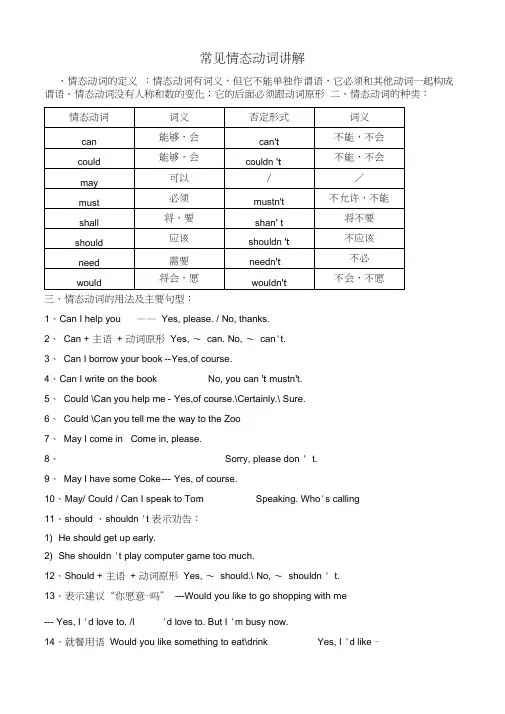
常见情态动词讲解、情态动词的定义:情态动词有词义,但它不能单独作谓语,它必须和其他动词一起构成谓语。
情态动词没有人称和数的变化;它的后面必须跟动词原形二、情态动词的种类:三、情态动词的用法及主要句型:1、Can I help you ——Yes, please. / No, thanks.2、Can + 主语+ 动词原形Yes, ~can. No, ~can't.3、Can I borrow your book -- Y es,of course.4、Can I write on the book No, you can 't mustn't.5、Could \Can you help me - Yes,of course.\Certainly.\ Sure.6、Could \Can you tell me the way to the Zoo7、May I come in Come in, please.8、Sorry, please don ' t.9、May I have some Coke --- Yes, of course.10、May/ Could / Can I speak to Tom Speaking. Who's calling11、should 、shouldn 't 表示劝告:1) He should get up early.2) She shouldn 't play computer game too much.12、Should + 主语+ 动词原形Yes, ~should.\ No, ~shouldn ' t.13、表示建议“你愿意⋯吗” ---Would you like to go shopping with me--- Yes, I 'd love to. /I 'd love to. But I 'm busy now.14、就餐用语Would you like something to eat\drink Yes, I 'd like ⋯15、shall 用于第一人称(I, we), 可以表示“将”和表示建议“⋯⋯好吗”1) Where shall we have dinner2) Shall we go fishing --- All right. \OK. \Good idea.16、Must + 主语+ 动词原形---Yes, ~must.\No, ~needn't. 四.常见情态动词的区别:1. can (could)1) 表示能力,could 主要指过去时间。

Modal Verbs表示说话人的情绪、态度或语气的动词叫情态动词。
1)情态动词不能单独作谓语,没有人称,数的变化,即情态动词第三人称单数不加-s。
2)情态动词的否定式是在情态动词后面直接+not。
3)情态动词的疑问式是把情态动词提到主语前。
can, could(be able to)may, mightmust (have to)will, would shall, should ought to needdareI.can/ could1.___Can___ you speak Japanese Just a little.2.Only the judge ___can___ save her from prison.3.I ___could___ drive a car before I left middle school.4.It was so dark that I ___could___ see nothing.Note: 表能力、有权力(could是can的过去式)5.--___Can/Could ___ I go home now --Yes, you can.–No, you can’t.6.--___Can/Could___ I speak to Andrew7.You ___can’t___(not)smoke here.Note: (口语)允许、请求,表可以 (could非can的过去式,表委婉)8.It ___can___/could ____ be very cold here, even in spring.9.She is clever, but she ___can___/could___ be dull sometimes. Note: (表示偶然现象发生的可能性)有时会,时而可能10.It ___can’t___/couldn’t___(not) be my father. He is abroad now.11.There is someone outside. Who ___can___ it be12.You __can’t/couldn’t have seen him__ (not see) him. He was not there.13.She __ can’t/couldn’t have been ___(not be) more than six then.14.He __ can’t/couldn’t have finished___ (not finish) the work lastnight without your help.Note: 表推测(否定、疑问句)15.He __could have told__(tell) me the answer but he refused to. Note: 过去本能做而没有做16.You _cannot/ can never_________ do the work too well.17.You _cannot /can never__ be careful enough in your study.Note: cannot…too; can never... too; cannot enough再…都不为过;越…越好can & be able to区别:1. can 只有两种时态现在时can & 过去时 couldbe able to 有各种时态2. 用于一般所具有的能力,可以互换,但是当表示成功做到时,通常用be able to或manage to1.He _can/is able to_ write music.2.We shall __be able to__ finish the work soon.3.I haven’t_been able to_ find the book.4.He _could/was able to__ swim like a fish when he was young.5.I talked with her for a long time and finally I __was able to_ makeher believe me.6.The fire spread through the building quickly but everybody ___was ableto /managed___ to escape.II.may/might1.--__May___ I leave now--Yes, you __may__./Yes,please.--No, you __may not /can’t/mustn’t___.2. He asked if he _might_____ use the phone.3. We start early so that we _may/might___ arrive in time.Note: (允许、请求)可以4. __May__ you be happy all your life.Note: 祝、愿5. John is absent. He __may/might_____ be ill.6. It _may/might______ rain tomorrow or it __may/might_____ be merely cloudy.7. I can’t find my book. I _may/might have left___(leave) it in your office just now.8. You know this story very well. You _may/might have read___(read) it before.Note: 表推测9. We start early so that we ___may ___ arrive in time.10. I wrote down his telephone number so that I ___might___ remember it. Note: 表目的(用于目的状语从句中)maybe & may be11. He ___may be ___ here. I’m not sure.12. ____Maybe______ you should call him.13. –Are you going out tonight-- ____Maybe____.III.must1.You __must___ have a passport if you want to go abroad.2.Drivers __mustn’t___ drive after drinking.Note: (义务、责任、强制、命令)必须应该3.You _must_______ first finish your homework before you watch TV.4.--_Must________ I come tomorrow--Yes, you __must____.--No, you __needn’t/ don’t have to_____.Note: (说话者主观上的意愿、建议、命令等)应该、必须、务必5.Winter __must___ be followed by spring.6.All living things ___must___ die.Note: 表示客观规律不可避免性或必然性,注定要,必然(只用于肯定句)7.You __must___ be ill. I can see it from your face.8.You __must have read___(read) the book. You know the story very well.9.There’s much noise from next door. They __must be having__(have) aparty.Note: 表肯定推测Must & have to区别:1. have to 用于各种时态,还可和其它情态动词连用2. have to 表示因客观环境的迫使而不得不做某事1.-- Let’s see a movie tonight.--I’d love to, but I __have to____ take care of my mom.2. They __had to__ speed up, for the weather turned terrible.3. They will ___have to ___ get up early tomorrow.4. We may ___have to___ put off the plan.5. You ___don’t have to ___ tell him about it.不一定要6. You ___mustn’t ___ tell him about it. 一定不要IV.shall1.I __shall________ ring you as soon as I arrive.Note:将来时(第一人称)将要、会2.__Shall______ I open the window for you3.Let’s go to the cinema tonight, __shall___weNote: (在问句中表示说话人征求对方意见或提出建议,用于第一、三人称)…好么V. should & ought to1.We hoped that we __should______ be able to do that.Note: 用于过去将来时2.You _should/ought to____ be more careful next time.3._Should____ I call him and apologizeNote: (表示建议、劝告、命令、要求) 应该,必须(ought to 语气强)4.It’s 4:30. They __should______ be in New York by now.Note: (表示说话者根据一定的依据猜测、推测、推论等)该,可能5.You _should have told__(tell) me earlier about it, but you didn’t.6.You __shouldn’t have done_________ (do) that to your mother, but youdid.Note: 过去按理该…而实际没有…(常有责备、埋怨、惋惜之意)VI. will1.He _will____ come back soon.Note: 将来时2.I hope you __will____ succeed.3.I __will____ do my best to help you.Note: (表意愿、决心、承诺)要、愿、想、会、保证4.When he is in trouble, he __will______ turn to his coach for help.5.I _will___ turn you out of doors if you don’t keep quiet.Note: 状语从句VII. would1.He told us that he __would______ meet us at the airport.Note: 过去将来时2.--__Would______ you mind my smoking--Yes, _please don’t. /You’d better not. _______________.---No, __go ahead______________Note: 提出请求、邀请(委婉)3.I __would________ like to see a film tonight.4.I _would____ rather not leave you here.5._Would __ you please _not smoke____(not smoke) hereNote: 意愿、决心、喜欢等6.He _would_________ be delighted if I went to see him.7.If you had come earlier, you _would have seen__(see) him.Note: 条件句(虚拟)8.When he was young, he __would__often __walk___ (walk) in these woods. Note: (表过去习惯性、经常性的行为或动作)总是VIII. need (情态动词没有过去式)Note: 1) need 作实意动词,有人称、时态和数的变化2) need 作情态动词,只能用在否定句和疑问句中,没有人称、时态和数的变化need sth don’t need sth Do … need sthneed to do don’t need to do Do …need to do…needn’t do Need …do …1.He __needs to_________(go) there now.2.He _need not/ doesn’t need to go__ (not go) there now.3.--__Need_/Does ______he ____go_/need to go___(go) there now-- Yes, he _must__/does______.--No, he _needn’t_/doesn’t________.4. He needs to finish the work by Friday, ___doesn’t______ he5. He needn’t stay there, __need_______ he6.He __needn’t have given_____ (not give) her so much money at the time,and now he regrets it.Note: needn’t have done过去本不必做却做了need doing & need to be done7.I _need to__ (repair) the computer.The computer __needs repairing_____.(repair)The computer __needs to be repaired____(repair)IX. dare (情态动词有过去式dared)Note: 1) dare作实意动词,有人称、时态和数的变化2) dare作情态动词,只能用在否定句和疑问句中,没有人称和数的变化,但有过去时。